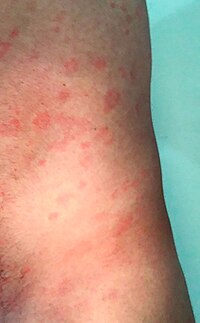A Jarisch–Herxheimer reaction is a sudden and typically transient reaction that may occur within 24 hours of being administered antibiotics for an infection by a spirochete, including syphilis, leptospirosis, Lyme disease, and relapsing fever.[1] Signs and symptoms include fever, chills, shivers, feeling sick, headache, fast heart beat, low blood pressure, breathing fast, flushing of skin, muscle aches, and worsening of skin lesions.[1] It may sometimes be mistaken as an allergy to the antibiotic.[1]
| Herxheimer reaction | |
|---|---|
 | |
| Jarisch-Herxheimer reaction in a patient with syphilis and HIV infection | |
| Pronunciation | |
| Specialty | Infectious disease |
Jarisch–Herxheimer reactions can be life-threatening because they can cause a significant drop in blood pressure and cause acute end-organ injury, eventually leading to multi-organ failure.[1]
Signs and symptoms
editIt comprises part of what is known as sepsis and occurs after initiation of antibacterials when treating Gram-negative infections such as Escherichia coli and louse- and tick-borne infections. It usually manifests in 1–3 hours after the first dose of antibiotics as fever, chills, rigor, hypotension, headache, tachycardia, hyperventilation, vasodilation with flushing, myalgia (muscle pain), exacerbation of skin lesions and anxiety. The intensity of the reaction indicates the severity of inflammation. Reaction commonly occurs within two hours of drug administration, but is usually self-limiting.[2]
Causes
editThe Jarisch–Herxheimer reaction is traditionally associated with antimicrobial treatment of syphilis.[3] The reaction is also seen in the other diseases caused by spirochetes: Lyme disease, relapsing fever, and leptospirosis.[4] There have been case reports of the Jarisch–Herxheimer reaction accompanying treatment of other infections, including Q fever, bartonellosis, brucellosis, trichinellosis, and African trypanosomiasis.[3]
Pathophysiology
editLipoproteins released from treatment of Treponema pallidum infections are believed to induce the Jarisch–Herxheimer reaction.[3] The Herxheimer reaction has shown an increase in inflammatory cytokines during the period of exacerbation, including tumor necrosis factor alpha, interleukin-6 and interleukin-8.[5][6]
Treatments
editProphylaxis and treatment with an anti-inflammatory agent may stop progression of the reaction. Oral aspirin or ibuprofen every four hours for a day or 60 mg of prednisone orally or intravenously has been used as an adjunctive treatment [citation needed]. However, steroids are generally of no benefit. Patients must be closely monitored for the potential complications (collapse and shock) and may require IV fluids to maintain adequate blood pressure. If available, meptazinol, an opioid analgesic of the mixed agonist/antagonist type, should be administered to reduce the severity of the reaction. Anti TNF-α may also be effective.[7][8]
History
editBoth Adolf Jarisch,[9] an Austrian dermatologist, and Karl Herxheimer,[10] a German dermatologist, are credited with the discovery of the Jarisch–Herxheimer reaction. Both Jarisch and Herxheimer observed reactions in patients with syphilis treated with mercury. The reaction was first seen following treatment in early and later stages of syphilis treated with Salvarsan, mercury, or antibiotics. Jarisch thought that the reaction was caused by a toxin released from the dying spirochetes.[11]
See also
edit- Jarisch-Bezold reflex
- Immune reconstitution inflammatory syndrome, another systemic inflammatory syndrome that arises after antimicrobial treatment
References
edit- ^ a b c d Dhakal, Aayush; Sbar, Evelyn (2023). "Jarisch Herxheimer Reaction". StatPearls. StatPearls Publishing.
- ^ Lukehart, Sheila A. (2017). "Syphilis". In Kasper, Dennis L.; Fauci, Anthony S. (eds.). Harrison's Infectious Diseases (3 ed.). New York: Mc Graw-Hill. p. 666. ISBN 978-1-259-83597-1.
- ^ a b c Belum GR, Belum VR, Chaitanya Arudra SK, Reddy BS (2013). "The Jarisch-Herxheimer reaction: revisited". Travel Medicine and Infectious Disease. 11 (4): 231–7. doi:10.1016/j.tmaid.2013.04.001. PMID 23632012.
- ^ Butler T (2017). "The Jarisch-Herxheimer Reaction After Antibiotic Treatment of Spirochetal Infections: A Review of Recent Cases and Our Understanding of Pathogenesis". The American Journal of Tropical Medicine and Hygiene. 96 (1): 46–52. doi:10.4269/ajtmh.16-0434. PMC 5239707. PMID 28077740.
- ^ Vidal V, Scragg IG, Cutler SJ, et al. (December 1998). "Variable major lipoprotein is a principal TNF-inducing factor of louse-borne relapsing fever". Nat. Med. 4 (12): 1416–20. doi:10.1038/4007. PMID 9846580. S2CID 23842774.
- ^ Kaplanski G, Granel B, Vaz T, Durand JM (July 1998). "Jarisch–Herxheimer reaction complicating the treatment of chronic Q fever endocarditis: elevated TNFalpha and IL-6 serum levels". J. Infect. 37 (1): 83–4. doi:10.1016/S0163-4453(98)91120-3. PMID 9733392.
- ^ Fekade, D; Knox, K; Hussein, K; Melka, A; Lalloo, DG; Coxon, RE; Warrell, DA (Aug 1, 1996). "Prevention of Jarisch–Herxheimer reactions by treatment with antibodies against tumor necrosis factor alpha". The New England Journal of Medicine. 335 (5): 311–5. doi:10.1056/NEJM199608013350503. PMID 8663853.
- ^ Coxon, RE; Fekade, D; Knox, K; Hussein, K; Melka, A; Daniel, A; Griffin, GG; Warrell, DA (Mar 1997). "The effect of antibody against TNF alpha on cytokine response in Jarisch–Herxheimer reactions of louse-borne relapsing fever". QJM: Monthly Journal of the Association of Physicians. 90 (3): 213–21. doi:10.1093/qjmed/90.3.213. PMID 9093599.
- ^ Jarisch A (1895). "Therapeutische Versuche bei Syphilis". Wien Med Wochenschr. 45: 721–42.
- ^ Herxheimer K, Krause D (1902). "Ueber eine bei Syphilitischen vorkommende Quecksilberreaktion". Deutsche Medizinische Wochenschrift. 28 (50): 895–7. doi:10.1055/s-0028-1139096.
- ^ "The Jarisch–Herxheimer reaction". Lancet. 1 (8007): 340–1. February 1977. doi:10.1016/s0140-6736(77)91140-0. PMC 1056841. PMID 64863.